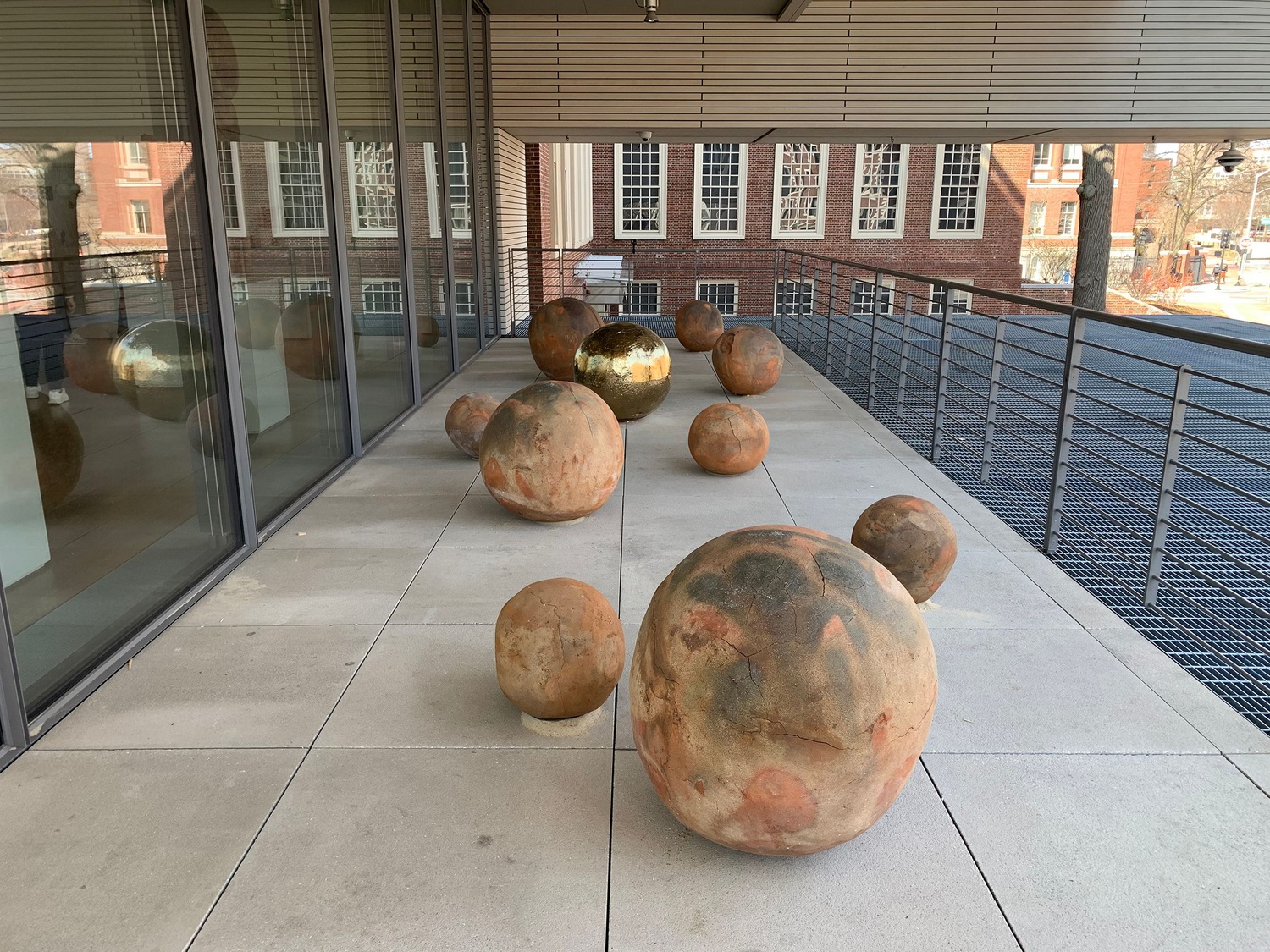
News
Summers Will Not Finish Semester of Teaching as Harvard Investigates Epstein Ties

News
Harvard College Students Report Favoring Divestment from Israel in HUA Survey

News
‘He Should Resign’: Harvard Undergrads Take Hard Line Against Summers Over Epstein Scandal

News
Harvard To Launch New Investigation Into Epstein’s Ties to Summers, Other University Affiliates

News
Harvard Students To Vote on Divestment From Israel in Inaugural HUA Election Survey
‘Origen’: Bosco Sodi Installs Reflective Contemplation at the Harvard Art Museums

Glancing down a corridor of first-floor galleries at the Harvard Art Museums, visitors may catch an unexpected glimpse of one of the museums’ newest residents: A gilded clay sphere is stationed on the floor of the gallery space, creating an otherworldly effect from its elemental interaction with the gallery’s natural light. Following its beckon deeper into the galleries, visitors encounter several more clay spheres of varying sizes and finishes — some are adorned with 17-karat-gold, others remain as warm-toned, earthy unglazed clay.
This site-specific installation, titled “Origen,” is the work of renowned Mexico City contemporary artist Bosco Sodi. Organized by Houghton Curator of Modern and Contemporary Art Mary Schneider Enriquez, the installation has been in the works since the pandemic and features 14 handmade clay spheres. Three golden pieces of the exhibit are making their U.S. debut at Harvard, and 12 of the spheres sit outdoors in the first terrace display in Harvard Art Museums’ history.
Each sphere is the product of an extensive process of creation which attaches the forces and elements of nature to the physical art. After sculpting the spheres from Oaxaca clay with local artists, Sodi allows the spheres to dry for nearly a year before baking them in an outdoor kiln on the banks of the Pacific. The result is a manifestation of centuries-old Zapotec terracotta sculpture tradition and the effects of today’s natural processes. Cracks, indentations, and color variations in the clay surface demonstrate the natural mutability and individuality of every piece Sodi creates.
“Origen” means “source” in Spanish, evoking a sense of centrality and beginning in both the clay globes’ materials and spiritual connotations. Though installed within a modern context, the spheres’ origin can be traced back to age-old traditions and elements.
“Bosco Sodi’s work speaks to the material and to the body, to the earth and to the essential thread connecting human beliefs and existence to the world we inhabit,” said curator Schneider Enriquez.
In addition, the world selected for Sodi’s spheres to inhabit is anything but unintentional. Coaxing visitors on a journey through displays of Chinese funerary and Asian Buddhist displays, the globes become points of consolidation for the meditative air of the surrounding objects. Viewers find themselves integrated with both Sodi’s work and the host gallery as they follow an organic path of circumambulation around the indoor spheres. Leaning in to investigate a golden sphere, the visitor finds yet another layer of images on display within the singular object — their own reflection, framed by that of the nearby Buddhist figures. The sphere’s mirroring surface, slightly muddled and cracked, challenges its viewer to reflect while subtly morphing their own appearance.
As the spheres continue from gallery to terrace, the effect of Sodi’s work is amplified by its outdoor lodging: The pieces become topics in the conversation between the Harvard Art Museums’ sleek modern additions by Renzo Piano and the 1927 Fogg Museum’s preserved brick facade. At once fundamental and complex, Sodi’s spheres energize and absorb the surrounding space. The pieces seem as if they had not been installed at all, but were brought to life by the dialogue of the museum architecture.
Sodi’s “Origen” expertly mirrors and grounds its museum context within its gold and terracotta forms, captivating the viewer in its alternating themes of reflection and absorption. Immediately eye-catching with a lingering atmosphere of contemplation, the installation explores the intangible through tangible materials to ground human experience to the source of the natural world. “Origen” can be seen on display at the Harvard Art Museums through June 9, 2024.
—Staff writer Marin E. Gray can be reached at marin.gray@thecrimson.com.
Want to keep up with breaking news? Subscribe to our email newsletter.
